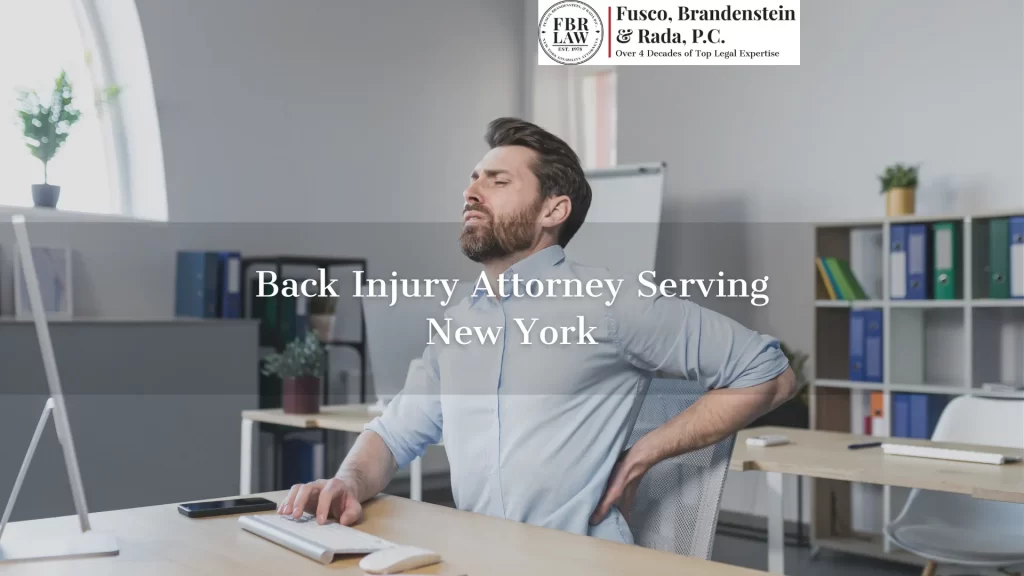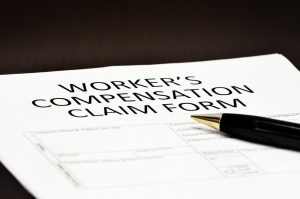
Are you suffering from a back injury due to a workplace accident? Is your work contributing to a chronic back injury? You are not alone. Back injuries are common in the workplace. According to the Bureau of Labor Statistics, there were 128,220 cases of back injuries in the private sector in 2020.
When you get injured at work, your employer is required to provide workers’ compensation benefits to lessen the financial burden of your injury. Unfortunately, some employers try to avoid paying you these important benefits or drastically underpay you for your suffering. That’s why you need to hire an experienced New York workers’ compensation lawyer from Fusco, Brandenstein & Rada, P.C. to fight for you and your rights.
Fusco, Brandenstein & Rada, P.C. has represented New York workers with back injuries for over 40 years. You shouldn’t have to suffer the consequences of a work-related injury without help. Allow the experienced attorneys at Fusco, Brandenstein & Rada, P.C. to advocate for you and the compensation you need and deserve. Contact our office at 516-496-0400.
Factors That Lead to Back Injuries at Work
Nearly any worker in any industry can suffer a back injury or back pain. Back injuries encompass a broad range of medical conditions that range from mild and acute injuries to severe and chronic ones.
Generally, back injuries are caused by three factors:
- Force – Back injuries can be caused by placing too much force on your back. For example, lifting a heavy object, pushing or pulling strenuously, twisting in an awkward direction, or slipping and falling are actions that could cause a back injury.
- Repetition – Repetitive activities can also cause a back injury, even when you’re not overexerting yourself. For example, standing for hours without breaks, repetitively lifting your arm, or frequently bending over could cause back injuries.
- Inactivity – Just sitting can also cause back injuries. If you work at a computer and sit for hours on end, you can also suffer back pain and injury, particularly if your office setup is not ergonomic.

The Anatomy of the Back
Your back is a complex structure that includes bones, muscles, ligaments, tendons, cartilage, discs, nerves, and much more. The main structure of your back is the spine. The spine is comprised of three segments, and each segment is made up of multiple vertebrae, or little bones that, when stacked together, make up the spine. The cervical spine is the upper section, commonly referred to as the neck, and is made up of seven vertebrae. The thoracic spine is the middle portion of your back, between the shoulder blades, and consists of 12 vertebrae. The lumbar spine, or lower back, consists of five vertebrae. Below the lumbar spine is the sacrum, which connects your spine to the pelvis. A normal spine creates an S-like curve.
Traveling up the middle of your vertebrae is the spinal cord, a column of nerves that connect to your brain and make up your central nervous system. The vertebrae play an important role in protecting your spinal cord. Intervertebral discs sit in between each vertebra and act as a cushion when you move. Each disc has a soft, jelly-like nucleus, surrounded by an outer shell called the annulus.
Ligaments attach the vertebrae to one another, and tendons attach the vertebrae to muscles. Your back has 40 muscles – 20 on the right side and 20 on the left side. Some back muscles are very large, such as the latissimus dorsi or “lats,” which are wing-shaped muscles that wrap around the side of your back and help move your arms and shoulders. Others are very small, such as the lumbar multifidus muscles, which run directly along the vertebral column and stabilize the lumbar spine.
If you have pressing questions, don’t hesitate to contact Fusco, Brandenstein & Rada, P.C.. We have the experience your case needs.
Common Back Injuries at Work
There are a number of injuries that can occur in the workplace:
- Sprains and strains: These soft muscle injuries can occur when you overexert yourself, like when you lift, push, or pull a heavy object. A sprain is a stretch or tear in a ligament, or the tissue that connects bones together. A strain is an injury to a muscle or tendon, often referred to as “pulling” a muscle.
- Herniated discs: A herniated disc occurs when some of the squishy nucleus of the discs pushes out through a tear in the annulus. This condition is also referred to as a slipped, ruptured, or bulging disc. Herniated discs are usually caused by gradual wear and tear on your back, known as disc degeneration.
- Pinched nerves: A pinched, or compressed, nerve occurs when there is too much pressure on a particular nerve from the surrounding tissue, causing pain, numbness, and tingling. A pinched nerve can be caused by an accident, repetitive motion, or age-related wear and tear.
- Vertebral fracture: A fractured or dislocated vertebrae is typically caused by a serious accident or trauma, such as a high-velocity impact or fall from a great height.
Filing for Workers’ Compensation Benefits
If your back injury is a result of a workplace accident, you would rightfully expect your employer, through their insurance company, to cover your medical bills, ongoing treatment, and lost wages. Too often, workers must fight to get the support and compensation they need. Here are some important things you need to know when filing for workers’ compensation benefits for your back injury:
- Hire a lawyer: The laws about workers’ compensation and back injuries are complicated and confusing. That’s why you need to hire an experienced back injury lawyer, like the ones from Fusco, Brandenstein & Rada, P.C..
- Report your injury to your employer: It is important that you report your back injury to your employer immediately, both verbally and in writing.
- See a back doctor: Your employer’s insurance company will look for evidence of a legitimate back injury before they approve your claim. That’s why it’s important to see an experienced back doctor as soon as possible after your injury. Back injuries are not always visible on imaging, such as x-rays and MRIs. A doctor who specializes in the anatomy of the back and injuries related to the spine and its supporting components will be able to spot the signs and symptoms of your back injury.

Contact Fusco, Brandenstein & Rada, P.C. for Help
Back injuries can be debilitating. If you suffered a back injury at work, call the experienced attorneys of Fusco, Brandenstein & Rada, P.C. for help with your workers’ compensation claim or appeal. Fusco, Brandenstein & Rada, P.C. has represented New York workers for over 40 years, and we are prepared to fight for you and your rights. Contact our office today at 516-496-0400.
